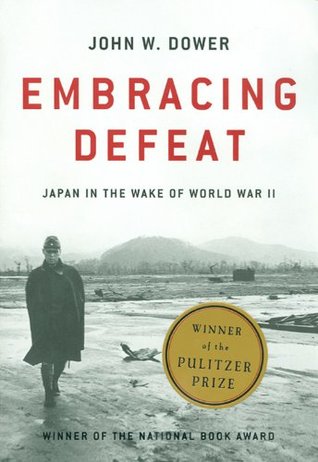More on this book
Community
Kindle Notes & Highlights
notorious facilities such as the Ofuna
vivisections
By far the largest number of aliens in Japan were other Asians, the great majority Koreans who had been conscripted to perform heavy labor.
Okinawa
More than ten thousand Americans died in that battle, which lasted from April to June 1945. Imperial forces numbering over 110,000 men were virtually wiped out, and approximately one-third of the civilian population—possibly as many as 150,000 men, women, and children—were killed.
“repatriation camps” in Japan.
scabies
Missing Persons continued on the air until March 31, 1962.38
many demobilized veterans returned from other places than the U.S.S.R. cynical and contemptuous of the officers who had led them in battle.
The group cohesion and discipline of the military hierarchy had not been built, as its propagandists intoned, on some idealized notion of “loyalty” or “harmony,” but on a structure of authoritarian coercion that transferred oppression downward.
atomization.
By 1946, when the tide of repatriates became a flood, those at home were already being exposed to a steady flow of information concerning the shocking range of atrocities committed by the imperial forces in China, Southeast Asia, and the Philippines, as well as against Allied prisoners generally. As a result, many ex-servicemen found themselves regarded not just as men who had failed disastrously to accomplish their mission, but also as individuals who had, it was assumed, participated in unspeakable acts.
The policeman did not arrest him, but gave him a hundred yen and some of his own clothing, while urging him to have faith in his ability to surmount his difficulties.
a mild Buddhist tradition of care for the weak and infirm,
Japan was a harsh, inhospitable place for anyone who did not fall into a “proper” social category.
There existed no strong tradition of responsibility toward strangers, or of unrequited philanthropy, or of tolerance or even genuine sympathy (as opposed to occasional sentimentality) toward those who suffered misfortune.
it was an especially conspicuous phenomenon in Japan
mental illness remained a taboo and those in need of help were usually consigned to the shadows and back rooms. Physical handicaps or deformities provoked a similar public aversion.
War orphans and homeless children almost by definition became “improper” children. Forced to scramble for daily survival on the streets, they became treated as incorrigible delinquents. Long after the war ended, the government not only had no effective policy for caring for these children, but scant grasp of the dimensions of the problem.
One of the most fashionable slogans of the early postsurrender period envisioned Japan becoming a “nation of culture.” In October 1946, Hayashi Fumiko, a well-known fiction writer from an impoverished background herself, argued in a popular magazine that no country so indifferent to the plight of orphans and the homeless could claim to be cultured.
Pandora’s box (Urashima Tarō’s box, in the Japanese idiom)
Formally, the period from August 1945 to April 1952 when Japan was subject to foreign control was known as the Allied occupation of Japan.
With a minimum of rumination about the legality or propriety of such an undertaking, the Americans set about doing what no other occupation force had done before: remaking the political, social, cultural, and economic fabric of a defeated nation, and in the process changing the very way of thinking of its populace.
comparable occupation policies were followed in Germany.
MacArthur and the cadre of reformers who initially gathered under his command conveyed a messianic fervor that had no real counterpart in Germany,
supine
Where Nazism was perceived as a cancer in a fundamentally mature “Western” society, Japanese militarism and ultranationalism were construed as reflecting the essence of a feudalistic, Oriental culture that was cancerous in and of itself.
accountable for committing “crimes against peace” and “crimes against humanity” that had no precedent in international law.
V. A. Röling, the Dutch judge at the Tokyo trials, later acknowledged the many “unfair features” and “grave errors” of these proceedings,
Suddenly, abstract statements about promoting democracy had become exceedingly specific.
This was an extraordinary, and extraordinarily fluid, moment—never seen before in history and, as it turned out, never to be repeated.
milieu,
“liberation” for most Japanese was not political but psychological.
Explanation of Postwar New Terms,
kyodatsu concept. Originally, it explained, this had been a clinical term used to describe physical or emotional prostration in individual patients.
the “distracted” and “dejected” condition of the p...
This highlight has been truncated due to consecutive passage length restrictions.
demoralization, or kyodatsu.3
exacerbated by the confusion, corruption, and ineptitude of the postsurrender elites.
Food shortages had begun to appear in some parts of the country even before Pearl Harbor,
That year, officials in Osaka prefecture estimated that 46 percent of all economic crimes in their jurisdiction involved food.
beriberi.
starvation became a major cause of death among fighting men.
The most common household diet consisted of barley and potatoes,
acorns, grain husks, peanut shells, and sawdust
(Sawdust, it was explained, could be broken down with a fermenting agent, transformed into a powder, and mixed in a ratio of one to four with flour to make dumplings, pancakes, or bread).
Protein deficiencies could be remedied by eating silkworm cocoons, worms, grasshoppers, mice, rats, moles, snails, snakes, or a powder made by drying the blood of cows, horses, and pigs.
Well sterilized, the researchers reported, mice and rats tasted like small birds, but it was important to avoid eating their bones since it had been demonstrated that this caused people to lose weight.


